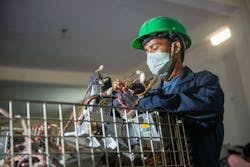Look around. Chances are, you’re surrounded by manufactured products—from the chair you’re sitting on to the device you’re reading this on. Each step along the manufacturing processes for those products creates carbon emissions, from the extraction of raw material to its disposal at the end of its useful life.
Reducing That?
Every manufactured object started off as raw materials. This could be a tree for wooden objects, or mined ores, quarried stones, or oil found deep underground. Resource extraction alone contributes up to half of all carbon emitted into the atmosphere. However, despite the effect harvesting natural resources has on the environment, extraction companies are simply producing to meet demands.
After extraction, the equipment that processes raw materials sends another large amount of carbon into the atmosphere. Each component in industrial equipment comes with its own embedded carbon, which consists of all the carbon emissions generated across the component’s life.
The Problem with Electronics
Approximately two-thirds of electronics’ carbon emissions can be traced to making storage devices, semiconductors and PCB components, according to sustainability website Treehugger. And these components are found in a wide variety of electrical and electronic industrial equipment.
The electronic parts and components used to assemble computer products account for nearly 60% of the computer products’ carbon footprints. According to the same study, a further 40% is generated by carbon from various chemical, gases, metals and other semiconductor materials.
Nevertheless, sustainability is not only about carbon emissions, but also the use of rare earth metals in electronics. Some of these materials are scarce, so overproduction of electronics reduces the availability of these critical raw materials.
At the end of a product’s life, it is disposed of, which creates more waste and increases carbon levels. An estimated $55 billion in e-waste material is thrown away annually in the U.S., according to The Balance, a business website. Unfortunately, only 20% of all e-waste is documented as having been collected and recycled, despite the potentially high reusability of materials such as gold and copper.
Stepping Forward
From a manufacturing, repair and maintenance perspective, companies and designers have several steps they can take to control how much carbon is in their products and how much is emitted while making them. They can use less energy and add carbon capture or carbon offsetting to manufacturing processes to minimize waste.
Legislation is constantly evolving to reflect the need for industrial businesses to operate more sustainably. For example, the European Union’s Emissions Trading Scheme (ETS) introduced a cap on carbon emissions that companies can create each year, with any excess emissions requiring the trading of carbon credits. This establishes a financial incentive for manufacturers to minimize emissions.
On an equipment level, new European guidelines aim to reduce waste generated by equipment that is functional and compliant with energy specifications. For example, after July 1, 2021, lower-efficiency (IE1 and IE2) electric motors will no longer be accepted, and a wide range of motors will be held to higher standards. However, there is one exception: devices being repaired that use motors placed on the market before the new regulation came into force. This prevents scrapping equipment early if motors can be repaired. This should avoid problems if it is impossible to replace a non-compliant motor with a compliant one without disproportionate costs to end users.
Go Green with Obsolete Parts
One of the best ways to reduce environmental damage and increase sustainability is to assess whether a machine needs to be upgraded. Manufacturers are tempted to consider upgrades just because older components have broken down and spare parts are hard to find. However, upgrades should be deliberately planned according to a precise business growth strategy, not commissioned as a way to bypass the difficulties of coping with obsolescence.
Just like with new parts, each stockpiled obsolete part has created most of its carbon emissions but then just end up gathering dust in a warehouse. From there, the best outcome is that they are scrapped and recycled, possibly straight into new parts that hopefully get used.
When faced with a broken or worn-out part, businesses often choose potentially expensive upgrades to new models and machines, with the prospect of repeating this process when the machine wears out.
Parts become obsolete for a variety of reasons, such as new specifications or regulations, design changes or simply because the OEM stopped making them to make space for a newer model. These parts might still be in stock somewhere, but it will require a reliable parts supplier to find them.
Determining if obsolete parts will work in a machine opens the door to a two-pronged attack on potentially wasteful practices. First, if an obsolete part can be sourced, the demand for new parts is lowered. Secondly, using obsolete parts wherever practical makes the most of the resources, energy and associated carbon emitted on behalf of those parts.
Manufacturers should work with reliable suppliers to locate obsolete but still-working parts that will keep their production lines running, save their budgets and help the environment.
Claudia Jarrett is U.S. country manager at EU Automation, a company that sells new and used, refurbished and obsolete industrial automation spares.
